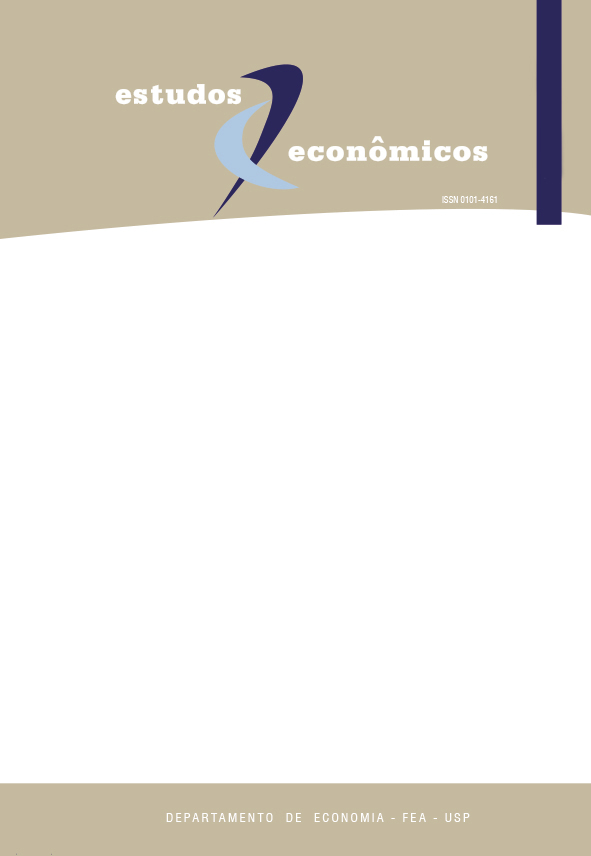Trajetória de crescimento para microempreendedores: diferencial de gênero dos clientes do programa crediamigo
DOI:
https://doi.org/10.1590/0101-416146373kvrPalavras-chave:
Microcrédito, Trajetória de Crescimento, Gênero.Resumo
Os programas de microcrédito têm sido adotados amplamente em diversos países como alternativa para inserção produtiva dos microempreendedores de baixa renda. Na maioria dos casos, os programas possuem um viés na alocação dos empréstimos em favor das mulheres, assumindo estas um compromisso maior com os pagamentos, a partir do seu melhor posicionamento na família e na sociedade. O objetivo deste trabalho é verificar se existe uma trajetória de crescimento para esse tipo de clientela, e se ela é diferenciada em relação ao gênero. Para isto, estimam-se equações de crescimento para os microempreendimentos dos clientes do Programa Crediamigo para o período de 2005 a 2009. Utilizam-se modelos lineares de efeitos mistos, como proposto por Rabe-Hesketh e Skrondal (2008). Os resultados mostram que existe uma trajetória de crescimento, mas com retornos decrescentes. Adicionalmente, as taxas médias de retorno são maiores para os homens; porém as mulheres possuem risco menor em suas trajetórias.
Downloads
Referências
ABDUL LATIF JAMEEL POVERTY ACTION LAB. Where credit is due. Disponível em: <http://www.povertyactionlab.org/publication/where-credit-is-due>. Acesso em: 01 mai. 2015.
AGHION, B.; MORDUCH, J. The Economics of Microfinance. Cambridge: MIT Press, 2005.
BADUNENKO, OLEG; BARASINSKA, NATALIYA; SCHÄFER, DOROTHEA. Risk attitudes and investment decisions across European countries: are women more conservative investors than men? Working Paper / FINESS 6.1, DIW Berlin, German Institute for Economic Research. 2009. BANCO DO NORDESTE DO BRASIL (BNB). Crediamigo. Disponível em: <http://www.bnb.gov.br/content/aplicacao/Produtos_e_Servicos/Crediamigo/gerados/Resultados.asp>. Acesso em 10 jul. 2013.
BANERJEE, A. Microcredit under the microscope: what have we learned in the past two decades, and what do we need to know? Annual Reviews of Economics 5, 487-519, 2013.
BARRETO, F. A. F. D.; SOARES, R. B.; TEIXEIRA, M. A. Saindo da pobreza com microcrédito. Condicionantes e tempo de ascensão: o caso dos clientes do crediamigo. Disponível em: <http://www.caen.ufc.br/~ataliba/ensaiocatorze>. Acesso em: 15 jul. 2010.
BÖNTE, W.; JAROSCH, M. Gender differences in competitiveness, risk tolerance, and other personality traits: do they contribute to the gender gap in entrepreneurship? Schumpeter discussion papers 2011-012. Schumpeter School of Business and Economics, University of Wuppertal, 2011.
BRYK, A.; RAUDENBUSH, S. A hierarchical model for studying school effects. Sociology of Education, v. 59, n. 1 (Jan., 1986), 1-17. Disponível em: <http://personal.psc.isr.umich.edu/yuxie-web/files/soc543-2004/Raudenbush_Bryk1986.pdf>. Acesso em: 19 mar. 2013.
CARREÑO, N. S., ESCOLAR, H. A. H., SAYAGO, J. A. M. Microcrédito y bienestar: uma evaluación empírica. Disponível em: <http://www.scielo.org.co/pdf/soec/n21/n21a09.pdf>. Acesso em: 19 mar. 2013.
CHESTON, S. Just the facts, ma’am: gender stories from unexpected sources with morals from microfinance, Ada Dialogue, 2006. Disponível em: <http://www.genfinance.info/documents/Gender%20Impact/Cheston_JusttheFactsMaam_2006.pdf>. Acesso em: 02 ago. 2013.
COSTA, F. N. da. Microcrédito no brasil. Campinas: IE/UNICAMP, 2012. (Texto para discussão n. 175).
CROSON, R.; GNEEZY, U. Gender Differences in Preferences. Journal of Economic Literature, 47:2, 1–27, 2009.
DUFLO, E. Women Empowerment and Economic Development. National Bureau of Economic Research Working Paper 17702, 2011.
FÁVERO, L.P.; BELFIORE, P.; SILVA, F, L.; CHAN, B, L. Análise de dados: modelagem multivariada para tomada de decisões. Rio de Janeiro: Elsevier, 2009.
FERNANDES, J. A. A. A importância do género no desenvolvimento das actividades do microcrédito: caso português. Disponível em: <https://www.repository.utl.pt/bitstream/10400.5/2390/1/A%20import%c3%a2ncia%20do%20g%c3%a9nero%20no%20desenvolvimento%20das%20actividades%20d.pdf>. Acesso em: 01 ago. 2013.
FIDA. Gender and rural microfinance: reaching and empowering women. 2009. Disponível em:
www.ifad.org/gender/pub/gender_finance.pdf>. Acesso em: 02 ago. 2013.
FONTES, A.; PERO, V. Determinantes do desempenho dos microempreendedores no brasil. Disponível em: <http://www.ie.ufrj.br/datacenterie/pdfs/seminarios/pesquisa/texto0906.pdf>. Acesso em: 03 fev. 2013.
FOSSEN, F. M. Gender Differences in Entrepreneurial Choice and Risk Aversion – A Decomposition Based on a Microeconometric Model. Discussion Paper 936, 2009.
MATLARY, F. H. What determines microenterprise growth? Disponível em: <http://brage.bibsys.no/nhh/bitstream/URN:NBN:no-bibsys_brage_34409/1/Matlary2012.PDF>. Acesso em: 06 set. 2013.
MEL, S.; MCKENZIE, D.; WOODRUFF, C. Who does microfinance fail to reach? Experimental evidence on gender and microenterprise returns. BREAD Working Paper No. 157, 2007.
MONZONI NETO, M. P. Impacto em renda do microcrédito: uma investigação empírica sobre geração de renda do crédito popular solidário (São Paulo Confia), no município de São Paulo. – Escola de Administração de Empresas de São Paulo, Fundação Getúlio Vargas, São Paulo, 2006. Disponível
em: <http://bibliotecadigital.fgv.br/dspace/bitstream/handle/10438/2499/61768.pdf?sequence=2>. Acesso em: 16 mar. 2013.
NERI, M. C. Microcrédito. O mistério nordestino e o grameen brasileiro. Perfil e performance dos clientes do Crediamigo. Editora da Fundação Getúlio Vargas, 375 p., 2008.
PITT, M.; KHANDKER, S. R. The Impact of Group-Based Credit Programs on Poor Households in Bangladesh: Does the Gender of the Participant Matter? Journal of Political Economy 106: 958-996, 1998.
PITT, M. M.; KHANDKER, S. R.; CARTWRIGHT, J. Does micro-credit empower women: evidence from Bangladesh. Policy Research Working Paper Series 2998, The World Bank, 2003.
RABE-HESKETH, S.; EVERITT, B. S. A Handbook of Statistical Analyses Using Stata. Boca Raton, FL: Chapman & Hall/CRC, Ed. 4, 2006.
RABE-HESKETH, S.; SKRONDAL, A. Multilevel and Longitudinal Modeling Using Stata. Texas, Stata Press Corporation, 2012.
RIGHETTI, C. C. B. Efeitos do microcrédito na geração de renda em microempreendimentos: avaliação de impactos do programa real microcrédito. Disponível em:<http://bibliotecadigital.fgv.br/dspace/bitstream/handle/10438/2576/71050100663.pdf?sequence=3>. Acesso em: 20 nov. 2012.
SEN, A. Desenvolvimento como liberdade. Tradução Laura Teixeira Mota. 1ª reimpressão. São Paulo: Companhia das Letras, 2000. 410 p.
SCHÖR, H. The profile of the successful entrepreneur, results of the survey “factors of business success”, 2006. Disponível em: <http://epp.eurostat.ec.europa.eu/cache/ITY_OFFPUB/KS-NP-06-029/EN/KS-NP-06-029-EN.PDF>. Acesso em: 05 ago. 2013.
STATACORP. Stata: Release 12. Statistical Software. College Station, TX: StataCorp LP, 2011.
YUNUS, M. O banqueiro dos pobres. Londres: Public Affairs, 1999, 343p.
WEST, B. T.; WELCH, K. B.; GALECKI, A. T. Linear mixed models. A practical guide using statistical software. Boca Raton, FL: Chapman & Hall/CRC, 2009.
WOOLDRIDGE, J.M. Econometric Analysis of Cross-Section and Panel Data. Cambridge: The MIT Press, 2002.
Downloads
Publicado
Edição
Seção
Licença
Copyright (c) 2016 Kamila Vieira Mendonça, Ricardo Brito Soares

Este trabalho está licenciado sob uma licença Creative Commons Attribution-NonCommercial 4.0 International License.
A submissão de artigo autoriza sua publicação e implica o compromisso de que o mesmo material não esteja sendo submetido a outro periódico.
A revista não paga direitos autorais aos autores dos artigos publicados.





 Atualizado em 14/08/2025
Atualizado em 14/08/2025